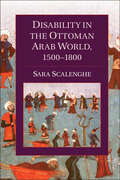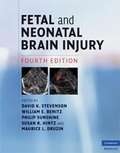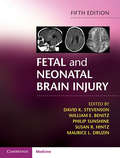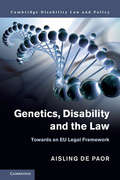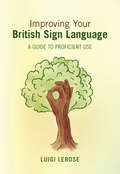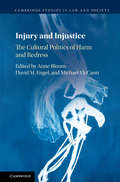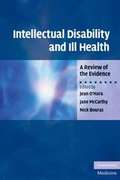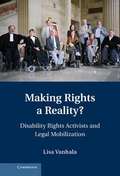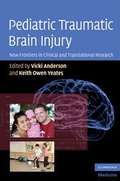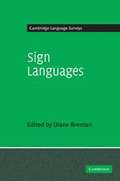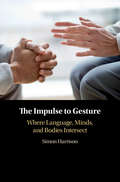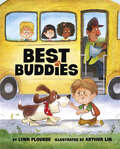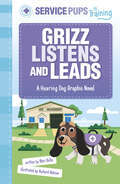- Table View
- List View
Disability and Political Theory
by Nancy J. Hirschmann Barbara ArneilThough disability scholarship has been robust in history, philosophy, English, and sociology for decades, political theory and political science more generally have been slow to catch up. This groundbreaking volume presents the first full-length book on political theory approaches to disability issues. Barbara Arneil and Nancy J. Hirschmann bring together some of the leading scholars in political theory to provide a historical analysis of disability through the works of canonical figures, ranging from Hobbes and Locke to Kant, Rawls and Arendt, as well as an analysis of disability in contemporary political theory, examining key concepts, such as freedom, power and justice. Disability and Political Theory introduces a new disciplinary framework to disability studies, and provides a comprehensive introduction to a new topic of political theory.
Disability and the Good Human Life
by Jerome E. Bickenbach Franziska Felder Barbara Schmitz Jerome E. Bickenbach Franziska FelderThis collection of original essays, from both established scholars and newcomers, takes up a recent debate in philosophy, sociology, and disability studies on whether disability is intrinsically a harm that lowers a person's quality of life. While this is a new question in disability scholarship, it also touches on one of the oldest philosophical questions: what is the good human life? Historically, philosophers have not been interested in the topic of disability, and when they are it is usually only in relation to questions such as euthanasia, abortion, or the moral status of disabled people. Consequently disability has been either ignored by moral and political philosophers or simply equated with a bad human life, a life not worth living. This collection takes up the challenge that disability poses to basic questions of political philosophy and bioethics, among others, by focusing on fundamental issues and practical implications of the relationship between disability and the good human life.
Disability in the Ottoman Arab World, 1500-1800 (Cambridge Studies in Islamic Civilization)
by Sara ScalenghePhysical, sensory, and mental impairments can influence an individual's status in society as much as the more familiar categories of gender, class, religion, race, and ethnicity. This was especially true of the early modern Arab Ottoman world, where being judged able or disabled impacted every aspect of a person's life, including performance of religious ritual, marriage, job opportunities, and the ability to buy and sell property. Sara Scalenghe's book is the first on the history of both physical and mental disabilities in the Middle East and North Africa, and the first to examine disability in the non-Western world before the nineteenth century. Unlike previous scholarly works that examine disability as discussed in religious texts such as the Qur'an and the Hadith, this study focuses on representations and classifications of disability and impairment across a wide range of biographical, legal, medical, and divinatory primary sources.
Family Policy and Disability
by Arie RimmermanThis book explores the status and scope of family policies related to households of children with disabilities, providing an in-depth, evidence-based review of legal, programmatic issues. It includes a discussion of the gaps between family needs and contemporary family policies in the United States and European countries, as demonstrated in these households' surveys. In addition, the volume offers a comparative analysis of cash benefits, tax credits and deductions, and in-kind provisions between the United States and select European countries (UK, France, and Sweden). Most importantly, this book identifies and continues the discussion regarding the critical role of family-centered policies, as expressed in the United Nations Convention on the Rights of Persons with Disabilities (UNCRPD), as well as the future of family policy toward families of children with disabilities at a time of economic crisis.
Fetal and Neonatal Brain Injury
by David K. Stevenson William E. Benitz Philip Sunshine Susan R. Hintz Maurice L. DruzinImprovements in the detection of fetal and neonatal brain injuries, advances in our understanding of the pathophysiology, cellular and molecular bases of encephalopathy, and new treatment options have all combined to produce significant changes in the management of neonatal brain disorders in the past few years. This new edition of Fetal and Neonatal Brain Injury brings the reader fully up to date with all advances in clinical management and outcome assessment. New material includes pregnancy-induced hypertension, HELLP syndrome and chronic hypertension, complications of multiple gestation, neurogenic disorders of the brain, neonatal stroke and much more. An expanded, highly illustrated chapter on structural and functional imaging of the fetal and neonatal brain is also included. An outstanding international team of highly experienced neonatologists and maternal-fetal medicine clinicians have produced a practical, authoritative clinical text that gives clear management advice to all clinicians involved in the treatment of these patients.
Fetal and Neonatal Brain Injury: Mechanisms, Management And The Risks Of Practice
by David K. Stevenson William E. Benitz Philip Sunshine Susan R. Hintz Maurice L. DruzinImprovements in the detection of fetal and neonatal brain injuries, advances in our understanding of the pathophysiology, cellular and molecular bases of encephalopathy, and new treatment options have all combined to produce significant changes in the management of neonatal brain disorders in the past few years. This new edition of Fetal and Neonatal Brain Injury brings the reader fully up to date with all advances in clinical management and outcome assessment. New material includes pregnancy-induced hypertension, HELLP syndrome and chronic hypertension, complications of multiple gestation, neurogenic disorders of the brain, neonatal stroke and much more. An expanded, highly illustrated chapter on structural and functional imaging of the fetal and neonatal brain is also included. An outstanding international team of highly experienced neonatologists and maternal-fetal medicine clinicians have produced a practical, authoritative clinical text that gives clear management advice to all clinicians involved in the treatment of these patients.
Genetics, Disability and the Law: Towards an EU Legal Framework (Cambridge Disability Law and Policy Series)
by Aisling De PaorWhile advances in science and technology bring many advantages, we must not ignore the harm that they can cause. Rapid changes in genetic testing are a prime example, and indicators can now help to detect, address and treat diseases. However, in this new study, Aisling de Paor examines how genetic testing is also being used for non-medical reasons, for example for work opportunities and insurance coverage. Genetics, Disability and the Law is the first book of its kind to substantively consider an EU-level response to the use of genetic information. de Paor discusses how to help genetic and scientific research to evolve and grow, how to enhance public confidence in research, and how to control it so that it recognises our values and fundamental human rights. An understudied but vitally important topic, de Paor's work provides a valuable and timely contribution to the field of disability rights. Presents a practical consideration of an EU-level legislative response to controlling the use and misuse of genetic information, appealing to those involved in the regulation of this field Takes a human rights and disability approach to considering the regulation of genetic information, which will interest scholars and policymakers from a variety of disciplines, in particular because it considers the intersection of disability and genetics Considers normative and non-normative attitudes to the regulation of genetic information, giving readers a new and varied insight
Health Inequalities and People with Intellectual Disabilities
by Eric Emerson Chris HattonPeople with intellectual disabilities die at a younger age and have poorer health than their non-disabled peers. This is largely avoidable and is unjust. This book uses concepts from contemporary public health to provide a comprehensive evidence-based overview of: the nature and extent of the health inequalities experienced by people with intellectual disabilities; why these inequalities occur and persist; and what can and needs to be done to address these inequalities. The authors have a wealth of firsthand experience gained from years of working at the interface between disability research and public health. This experience is collected and shared in this volume, which will be an invaluable resource for practitioners, advocates, policymakers and researchers concerned with health and social care and the wellbeing of disabled people.
Improving Your British Sign Language: A Guide to Proficient Use
by Luigi LeroseThis practical, illustrated guide is designed for students who want to improve their use of British Sign Language (BSL), helping them to manage some of the more challenging aspects of BSL learning in an accessible way. Written by a highly experienced sign language speaker, it contains around 750 photos of signs, including examples of common mistakes alongside the corresponding correct signs. Each chapter is accompanied by video demonstrations of all the signs it exemplifies, showing BSL in action. The book is based on the latest research on BSL within theoretical linguistics, since understanding the latest advances in this fast-moving field is known to help improve the skills of non-native speakers. It is intended primarily for self-study, allowing students to work at their own pace on articulation accuracy, recognise the kinds of errors they are likely to make, and gain a better understanding of the visual nature of BSL.
Injury and Injustice: The Cultural Politics of Harm and Redress (Cambridge Studies in Law and Society)
by David M. Engel Anne Bloom Michael McCannThis book addresses some of the most difficult and important debates over injury and law now taking place in societies around the world. The essays tackle the inescapable experience of injury and its implications for social inequality in different cultural settings. Topics include the tension between physical and reputational injuries, the construction of human injuries versus injuries to non-human life, virtual injuries, the normalization and infliction of injuries on vulnerable victims, the question of reparations for slavery, and the paradoxical degradation of victims through legal actions meant to compensate them for their disabilities. Authors include social theorists, social scientists and legal scholars, and the subject matter extends to the Middle East and Asia, as well as North America.
Intellectual Disability and Ill Health
by Jean O'Hara Jane Mccarthy Nick BourasPeople with intellectual disability often have health needs that go unrecognised and untreated; this may be because of difficulties in communication, diagnostic overshadowing, discrimination or indifference. There is concern that public health measures aimed at reducing the main health killers in the population will not address these issues for people with intellectual disability and may preferentially widen the inequality that already exists. This book is a comprehensive and systematic review of physical and mental health co-morbidities in people with intellectual disability. Such an evidence base is vital in shaping public health policy, healthcare commissioning and the development of more effective healthcare systems, as well as supporting better understanding and practice at an individual clinical level. This is essential reading for policy makers and commissioners of services, as well as individual practitioners across mainstream and specialist health and social care, in considering not only service developments but practice at the coalface.
Land Use Law and Disability
by Robin Paul MalloyIn Land Use Law and Disability, Robin Paul Malloy argues that our communities need better planning to be safely and easily navigated by people with mobility impairment and to facilitate intergenerational aging in place. To achieve this, communities will need to think of mobility impairment and inclusive design as land use and planning issues, in addition to understanding them as matters of civil and constitutional rights. Although much has been written about the rights of people with disabilities, little has been said about the interplay between disability and land use regulation. This book undertakes to explain mobility impairment, as one type of disability, in terms of planning and zoning. The goal is to advance our understanding of disability in terms of planning and zoning to facilitate cooperative engagement between disability rights advocates and land use professionals. This in turn should lead to improved community planning for accessibility and aging in place.
Making Rights a Reality? Disability Rights Activists and Legal Mobilization
by Lisa VanhalaMaking Rights a Reality? explores the way in which disability activists in the United Kingdom and Canada have transformed their aspirations into legal claims in their quest for equality. It unpacks shifting conceptualizations of the political identity of disability and the role of a rights discourse in these dynamics. In doing so, it delves into the diffusion of disability rights among grassroots organizations and the traditional disability charities. The book draws on a wealth of primary sources including court records and campaign documents and encompassing interviews with more than sixty activists and legal experts. While showing that the disability rights movement has had a significant impact on equality jurisprudence in two countries, the book also demonstrates that the act of mobilizing rights can have consequences, both intended and unintended, for social movements themselves.
Neurocognitive Rehabilitation of Down Syndrome
by Donna Spiker Jean-Adolphe Rondal Juan PereraDown syndrome is one of the most commonly occurring developmental disorders and it is now possible to conceptualize and define opportunities for neurocognitive rehabilitation for those with the condition. This book describes how early cognitive intervention in children with Down syndrome can be carried out, and can reduce, or compensate for, the major deficits characteristic of the condition. This comprehensive account relates the neurocognitive approach to the major therapeutic endeavors in the neighboring fields of neurogenetics, experimental environmental enrichment, molecular genetics, pharmacology, pediatrics and cardiology for infants with Down syndrome. Neurocognitive Rehabilitation of Down Syndrome provides the guidance required to establish effective rehabilitation programs, and is essential reading for developmental clinicians, pediatricians, neuropsychologists and other health professionals.
Pediatric Traumatic Brain Injury
by Vicki Anderson Keith Owen YeatesTraumatic brain injury (TBI) is a leading cause of death and disability in children and adolescents Worldwide and represents a largely "silent" public health epidemic. Advances in acute medical care have resulted in better survival rates, but long-term quality of life remains of ongoing concern. The cognitive, emotional and behavioral consequences of TBI frequently pose life long problems for these children and their families leading to substantial economic and societal costs.
Psychiatric and Behavioral Disorders in Intellectual and Developmental Disabilities
by Nick Bouras Hemmings, Colin and Bouras, Nick Colin HemmingsFully revised, this new edition reviews the most up-to-date and clinically relevant information on the mental health and behavioral problems of people with intellectual, developmental and learning disabilities, also previously known as mental retardation. Providing the latest evidence base from the literature and embracing clinical experience, it covers the essential facts and concepts relating to coexisting medical and psychiatric disorders, with new and updated chapters on mental health and epilepsy, schizophrenia spectrum disorders, personality disorders, and mental health problems in people with autism and related disorders. The disorder-based chapters are complemented by chapters on carer and family perspectives, possible future developments and contributions highlighting the principles of assessment, management and services from global and historical perspectives. This is essential hands-on practical advice for psychiatrists, psychologists and all other mental health professionals including nurses, therapists, social workers, managers, service providers and commissioners.
Reproductive Endocrinology for the MRCOG and Beyond
by Adam Balen Jenny HighamUnderstanding endocrinology is central to understanding the key processes that affect normal reproductive function, while an understanding of normal endocrinology and the pathophysiology of endocrine disorders is important when dealing with reproductive disorders. This book provides a comprehensive background for all gynaecologists, covering: sexual differentiation and intersex disorders; adrenal disorders; normal puberty and adolescence; abnormal puberty; the menstrual cycle; disorders of menstruation; amenorrhoea; polycystic ovary syndrome; anovulatory fertility and ovulation induction; lactation and lactational amenorrhoea; hyperprolactinaemia; thyroid disease; diabetes; lipid metabolism and lipoprotein transport; premature ovarian failure; and calcium metabolism and its disorders. The book is primarily designed to provide a comprehensive summary for candidates preparing for the Part 2 MRCOG examination, and as such covers the RCOG curriculum for reproductive endocrinology. It is also a valuable guide for all healthcare professionals working in the field, including trainees, consultants and any health professional coming into contact with women.
Sign Languages
by Diane BrentariThis series offers general accounts of the major language families of the world, with volumes organized either on a purely genetic basis or on a geographical basis, whichever yields the most convenient and intelligible grouping in each case. Each volume compares and contrasts the typological features of the languages it deals with. It also treats the relevant genetic relationships, historical development, and sociolinguistic issues arising from their role and use in the world today. The books are intended for linguists from undergraduate level upwards, but no special knowledge of the languages under consideration is assumed. Volumes such as those on Australia and the Amazon Basin are also of wider relevance, as the future of the languages and their speakers raises important social and political issues.
Social Class and Educational Inequality: The Impact of Parents and Schools
by Iram Siraj Aziza MayoSocial class is often seen as an intractable barrier to success, yet a number of children from disadvantaged backgrounds still manage to show resilience and succeed against the odds. This book presents the findings from fifty Child and Family Case Studies (CFCS) conducted with 13–16 year olds. The authors look specifically at the roles that people and experiences - at home, in schools and in the wider community - have played in the learning life-courses of these children; how these factors have affected their achievement; and explanations and meanings given by respondents to the unique characteristics, experiences and events in their lives. Featuring the voices of real parents and children, and backed up by a decade of quantitative data, this is a compelling record that will help readers to understand the complex nature of social disadvantage and the interplay between risk and protective factors in homes and schools that can make for a transformational educational experience.
Sociolinguistics and Deaf Communities
by Ceil Lucas Adam C. SchembriHow do people use sign languages in different situations around the world? How are sign languages distributed globally? What happens when they come in contact with spoken and written languages? These and other questions are explored in this new introduction to the sociolinguistics of sign languages and deaf communities. An international team brings insights and data from a wide range of sign languages, from the USA, Canada, England, Spain, Brazil and Australia. Topics covered include multilingualism in the global deaf community, sociolinguistic variation and change in sign languages, bilingualism and language contact between signed and spoken languages, attitudes towards sign languages, sign language planning and policy, and sign language discourse. Sociolinguistics and Deaf Communities will be welcomed by students of sign language and interpreting, teachers of sign language, and students and academics working in linguistics.
The Impulse to Gesture: Where Language, Minds, and Bodies Intersect
by Simon HarrisonGestures are central to the way people use language when they interact. This book places our impulse to gesture at the very heart of linguistic structure: grammar. Based on the phenomenon of negation - a linguistic universal with clear grammatical and gestural manifestations - Simon Harrison argues that linguistic concepts are fundamentally multi modal and shows how they lead to recurrent bindings between grammar and gesture when people speak. Studying how speakers express negation multi modally in a range of social and professional contexts, Harrison explores how and when people gesture, what people achieve linguistically and discursively with their gestures, and why we find similar uses of gesture in different languages (including spoken and signed language). Establishing the inseparability of grammar and gesture, this book is an important reference for any researcher interested in the relation between language, gesture, and cognition.
The Linguistics of British Sign Language
by Bencie Woll Rachel Sutton-Spence<P>This is the first detailed explanation of the way British Sign Language works and is the product of many years' experience of research and teaching sign linguistics to deaf and hearing people. It assumes no previous knowledge of linguistics or sign language, and is not structured around traditional headings such as phonology, morphology and syntax. Instead it is set out in such a way as to help learners and their teachers understand the linguistic principles behind the language. There are sections on BSL grammar and also on the use of BSL, including social acceptability in signing, variation, and poetry and humour in BSL. <P>Technical terms and linguistic jargon are kept to a minimum, and the text contains many examples from English, BSL, and other spoken and sign languages. The book is amply illustrated and contains exercises, as well as a reading list for further study.
eQuality
by J. D. Peter Blanck David BraddockNever before have the civil rights of people with disabilities aligned so well with developments in information and communication technology. The center of the technology revolution is the Internet's World Wide Web, which fosters unprecedented opportunities for engagement in democratic society. The Americans with Disabilities Act likewise is helping to ensure equal participation in society by people with disabilities. Globally, the Convention on the Rights of Persons with Disabilities further affirms that persons with disabilities are entitled to the full and equal enjoyment of fundamental personal freedoms. This book is about the lived struggle for disability rights, with a focus on Web equality for people with cognitive disabilities, such as intellectual disabilities, autism, and print-related disabilities. The principles derived from the right to the Web - freedom of speech and individual dignity - are bound to lead toward full and meaningful involvement in society for persons with cognitive and other disabilities.
Best Buddies
by Lynn PlourdeBest Buddies introduces a boy-and-dog duo who are BEST FRIENDS and who do EVERYTHING together! So how will they manage being apart when the boy heads to school for the first time? Find out how a clever boy with Down syndrome and his loyal pet find the perfect way to feel close even when they can’t be together. A sweet, inspiring story that will ease concerns about the first day of school and other big changes for kids.
Grizz Listens and Leads: A Hearing Dog Graphic Novel (Service Pups in Training)
by Mari BolteBasset hounds have long ears, and Grizz is ready to put his to good use. [CS1] He wants to become a hearing dog and help people. But when Grizz is paired with a pompous pup named Luca, he must use his patience and his ears to learn in this early graphic novel.

